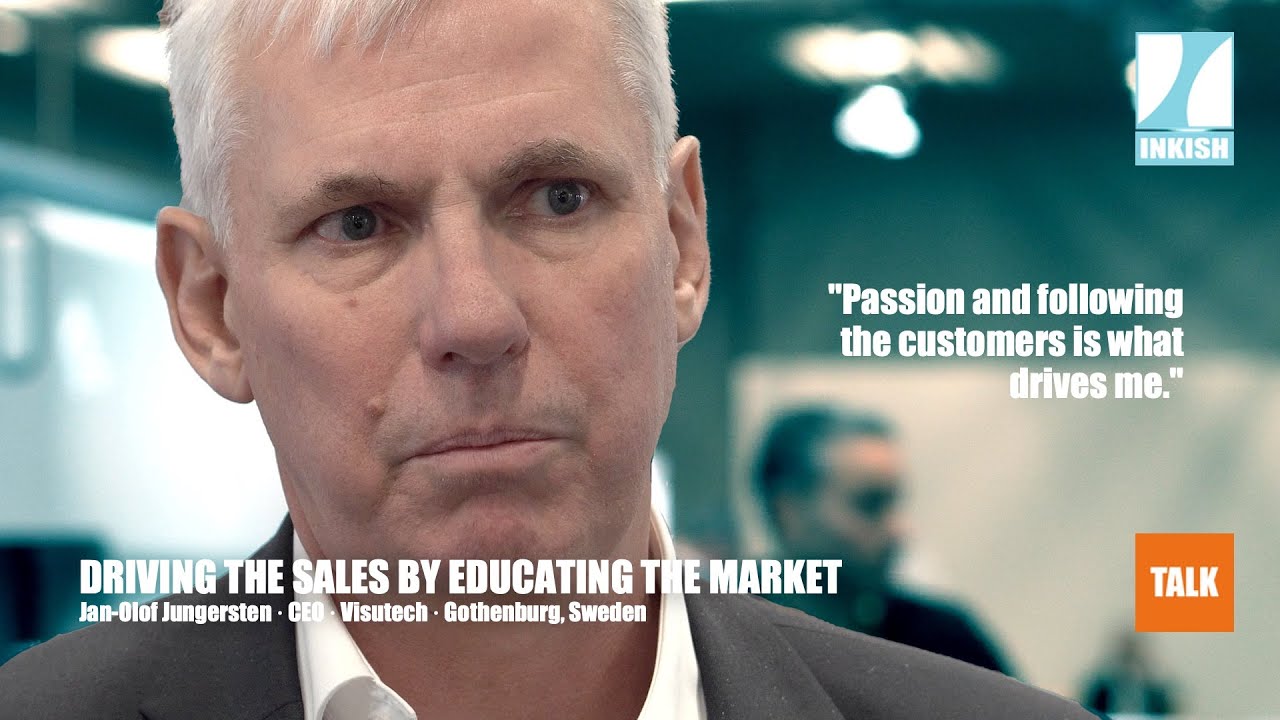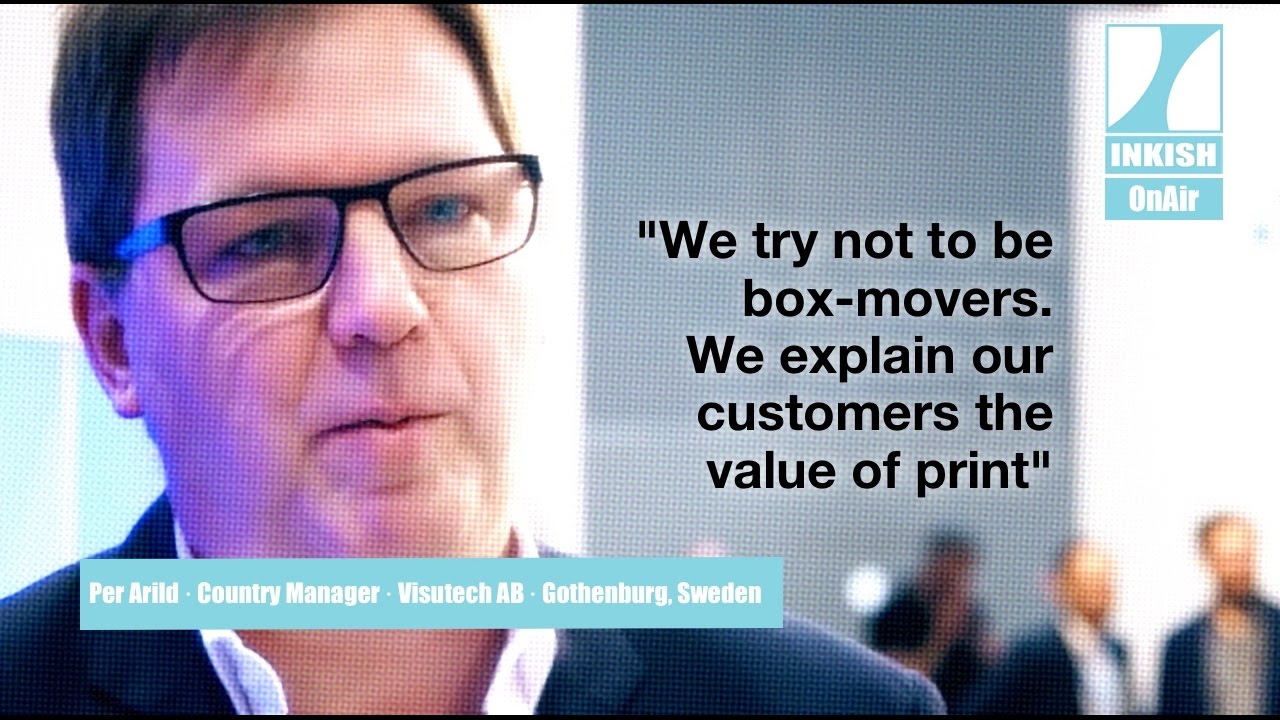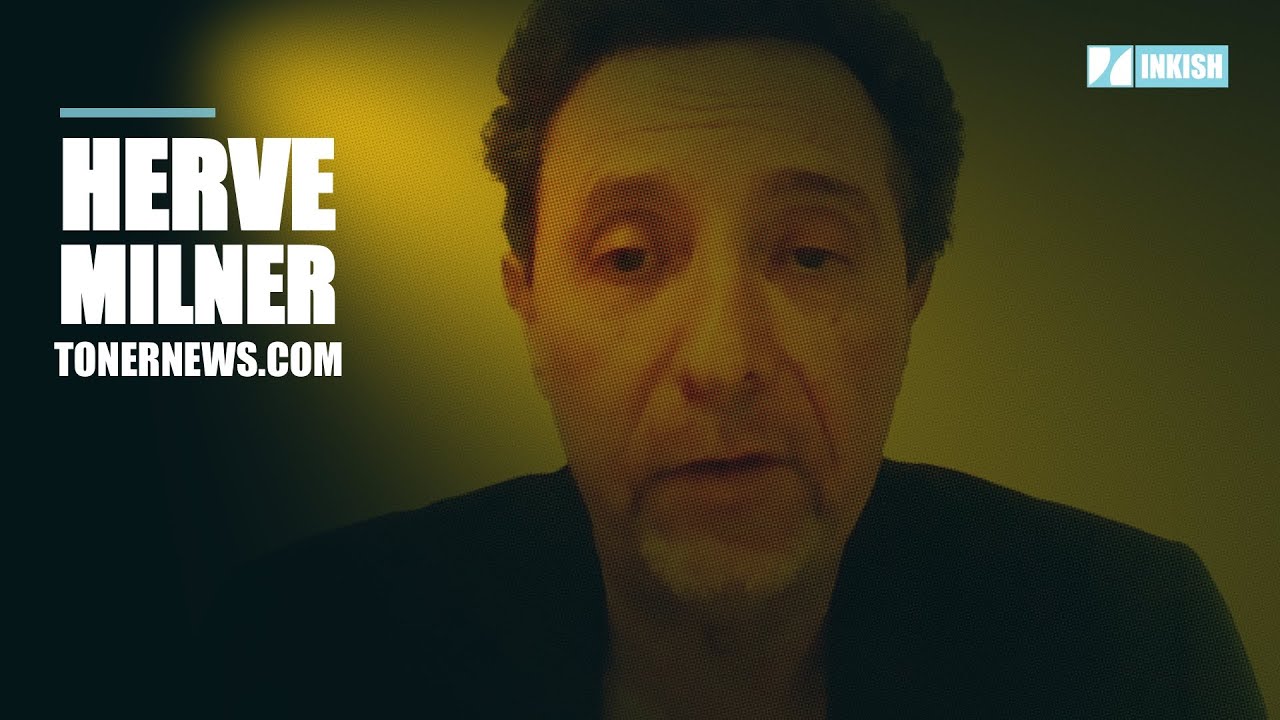Jan-Olof Jungersten is the distributor of HP Graphic Arts equipment in his company Visutech, in the Nordic and he and his company recently celebrated their 30 years anniversary at Scanpack 2018.
INKISH do not so often cover representatives but of course, we have exceptions.
Jan-Olof Jungersten is not only the first Indigo channel in the world, but he is also an author. His third book ‘Transmission – Transform the Packaging Industry’ is about how he sees the changes in demand, changes in technology, and how we as a printing industry needs to adapt to the new order of the world. As he says “digital is not only about the machines but also about the mindset” (free from memory). So, in this INKISH film, he shares some of his visions, some speculations, some considerations put in Swedish perspective – and of course, considerations about both HP and the market in general.
Enjoy!
Visutech today, it’s a company, a turnover of around 400 million Swedish crowns. We have 60 employees. We are covering the Nordic, Sweden, Norway, Denmark, and Finland. Half of the people are relating to technical part, surveying, getting the machine up and running out in the market.
Twenty-five years ago we started with Indigo. That was the launch of Indigo in Ipex 93. We installed the first machine, 94 in Sweden actually. We are the oldest and one of the first channels in the world.
Passion. And grow with the customer, which I think is a very … it’s very important to be close to your customer and grow together with them. That’s my success. If they don’t grow, I cannot grow.
Adding value. I mean the product is what the product is. It’s HP, it’s a big, huge supplier of, probably the best, as I see it, the best, the best product in the world. That’s not enough. It’s not making the business. The thing you have to do as a channel partner is adding value. If we don’t add value to our customer, they cannot add value to their customer, which are our consumer. So that’s the way we can grow the business and we can make success in our customer.
It was actually started 2008 on a strong belief on how should we actually tell the customers to do better business. How should they know how to do it? And education for me is crucial. And I split training with education. There’s two different things. Training is something you know, and you can be better on. Education is something you don’t know, but you have to learn.
So working with this in both horizontal and vertical, as a nonprofit for us will be a profit for us and for our customer in the future.
Yeah, we built that, when we moved into the last office. We’ve built an auditorium. We invested actually 900,000, 900,000 Euro in and use that up in Gothenburg for the Academy. Also the training center, which now it’s seven years since we moved in. So it’s time for next year, the Academy 2.0, which will be even more focused on education.
We had as a standard when we moved to an exhibition, we want to add value on an exhibition also, like we do here on Scanpack 2018. Important to not only show machines, which we do, for sure, but if we can add value, more people come from the same company, learn more things, making more value to the market.
And a good thing with sharing is you’re not losing anything. If you’re sharing, you actually, more people get the same knowledge. So you don’t give away anything, you’re actually only sharing and you can create. With share, you create new business, new opportunities and adding value. That’s the reason why we exist.
The easy answer why, why writing books, because that no one else doing that. So that’s the easiest part. The more complicated answer, in this case, it’s the big opportunity I had when I started. I’m not educated for, for being a boss or a company. There is no school for actually being a boss. I call it the wild information. The controlled inflammation, you can put in a book, the wild information is something you’ll learn by generation, et cetera, et cetera. So I had an opportunity to actually to create the company as I want to have it, and I built it in teams and no hierarchical discussion. So that’s an opportunity when you are just starting it from the beginning.
The title of it was the Transformation of the Packaging Industry. The first book is actually called Visions, the second book Vision and Transformations, describe it in genre. And the third book is now a very specific for packaging industry. It’s about transforming from analog to digital printing. Not only buying a machine. When you’re buying a digital press, sorry to say, most of the customers buying a machine say they are digital, and they offer digital, which is true by the machine, but it’s not true by the business. So this transformation has to be done, not only by the machine it’s also the mental training, the mental transformation.
And that’s what the book, it’s about. The book really take you through the whole process of changing business model, adding value and a new business model of pricing to the customer from a setup cost to per thousands of packaging, to price per second of the machine. You see, conventional press have maybe an effective time of 20% of the printing time is effective printing. When you come to digital, it’s the opposite. Not that fast, but 80%, it’s productive time. So why discussing setup times, instead of taking printing time instead. And this is meaning, the same price if you’re printing one or 1,000, or 10,000s.
Everything is going faster, that’s fine. That we can live with. But is the demand there? Is it driven by demand or is it driven by what’s actually existing in the market? I’m strong believing on demand. Which come first, the mobile phone as a technology or the demand? The right answer is the demand come before the phone, but you didn’t know it.
So this is what we doing. We have to learn our market. What the market need, we don’t need to create the need. The need is out there, together with the brand owner together with the converters, we can actually give the light of what the demand is, but if you don’t know how you should cycle a bike, for example. There is no book how to do that. You have to trial and error, and we have done the trial and error.
The technology is absolutely there, and the good thing with the packaging, most of the technology and the digital for printing part have already been developed for the commercial prints. So we utilize a lot of those base technology into the packaging. Yes, we have to control the media. We have to control the conversion of the media afterwards, et cetera. Most other people, consumer today, they don’t know if they have a label coming from digital or if it’s analog produced, which is our goal. We want to have the standard quality that they are used to. Because end user don’t know how it’s printed. If it’s printed flexo, offset or digital or whatever, they don’t care. They want to have the quality they’ll remember and they can recognize from the past. So they want to have a quality.
We can do better than the conventional. The real goal is that you should have the quality you are used to have, but in a different way. Like you can print one, or you can print millions.
HP gave us a lot of [inaudible 00:07:22] to serve our market, and we try to add the soft side of it, if we can talk about that? And if you get a machine, it’s not necessary that you are actually going to be digital if you’re actually have to do the process and also educating your customer. Otherwise they will be educating you, or chose another converter, which already have got it. And this lighting in the tunnel for a market, which today yet is still growing. The packaging market compared to commercial market is that they are growing. More marketing money coming onto packaging that in the past was on the commercial side.
So the brand only the really putting the money and the investment into the product, not only to protect them anymore, it’s also to sell the product. Even more important when you go to eCommerce, when you need that even more, because you cannot touch it. You have only thing is to see it. When you go into a shop, you have point zero second in a shelf to choose which of the one that you have an interest for. Three second later you have grabbed the thing. You are attracted.
That’s hard for the brand owners, not only what’s inside of a product, but those inside of the product, taking toothpaste for example. How many brands? Sorry to say, most of them are actually made by Unilever anyhow. But they have a lot of different brands produced by Unilever in the back.
So how can they come out and be the one you are choosing in the shop? Yes. 80% of the time you’re choosing the one you’d choose the last time. But the 20% is there and you may be changing if that’s empty or if you’re looking for something new. This is the eye to decide which you are taking.
This the biggest transformation in the industry that we will see in the future. And we expected to get the low economy. And I have a few of them that said, I love low economy when it comes. Why? Because transformation is only happening in the low economy. There is no one in a high economy that wants to change. But in a low economy, you have to find something new. It’s hard but you need to find new things, new values, as we say. Digital is absolutely there for this transformation.
The circle, normally it’s every eight years, you have a new low or high economy. Normally you control the timing by the low economies because the high is harder to say where are we on the top? So all the statistiker, they are counting by the low economy, which have the more interest. But now we have had actually the longest high economy even longer than the [Kriga 00:10:15] crash in ’26. Transformation, from something, to something new. The big, low economies in the curve is like we are, we are breathing. You cannot breathe in and breathe in again. You have to breathe out. It is how the life is.
This time I think it will be still eight year, but the problem is, Trump is actually pushing this high economy to the edge. It means that the down slope will be very deep, fast coming next low economy. How deep? I don’t have a clue.




























